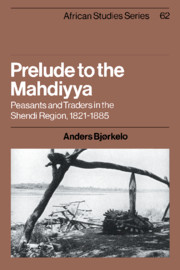Book contents
- Frontmatter
- Contents
- Figures
- List of maps
- List of tables
- Preface
- Acknowledgements
- Abbreviations
- Weights and measures
- The Sudan in the nineteenth century
- Introduction
- 1 The Ja'alī Kingdom of Shendi and its destruction
- 2 Shendi's economy on the eve of the Turkiyya
- 3 The Ja'aliyyīn under Turkish administration
- 4 The transformation of agriculture
- 5 Taxation
- 6 The transformation of commerce
- 7 Conclusion: dispersion and return
- Appendix: Three contracts from the archive of 'Abd Allāh Bey Ḥamza
- Notes
- Sources and bibliography
- Index
- OTHER BOOKS IN THE SERIES
- Frontmatter
- Contents
- Figures
- List of maps
- List of tables
- Preface
- Acknowledgements
- Abbreviations
- Weights and measures
- The Sudan in the nineteenth century
- Introduction
- 1 The Ja'alī Kingdom of Shendi and its destruction
- 2 Shendi's economy on the eve of the Turkiyya
- 3 The Ja'aliyyīn under Turkish administration
- 4 The transformation of agriculture
- 5 Taxation
- 6 The transformation of commerce
- 7 Conclusion: dispersion and return
- Appendix: Three contracts from the archive of 'Abd Allāh Bey Ḥamza
- Notes
- Sources and bibliography
- Index
- OTHER BOOKS IN THE SERIES
Summary
This is a history of a region and its people during a period of profound change. It seeks to describe and analyse the impact of Turco-Egyptian colonial rule (1821–85) on the Northern Sudan with particular reference to the peasants and traders among the Ja'aliyyīn people of the Shendi region. It will also to some extent be concerned with other groups such as the Shāyqiyya and the Danāgla, who were both neighbours of and settlers among the Ja'aliyyīn, and with whom the latter both cooperated and competed at home or in the diaspora.
According to the 1956 census, this region (roughly between 16½ and 18° latitude in the Nile Valley, i.e. between the Sixth Cataract and the Atbara River) contained about 300,000 people, including the population of Shendi town (11,031). By the early 1980s the population of the town had grown to around 20,000. Emigration from the rural areas is widespread and tends to keep the population growth in these areas down. The region's population figures from the early nineteenth century can only be guessed at, but it seems reasonable to assume a population figure of 40,000 to 50,000.
- Type
- Chapter
- Information
- Prelude to the MahdiyyaPeasants and Traders in the Shendi Region, 1821–1885, pp. ix - xPublisher: Cambridge University PressPrint publication year: 1989

